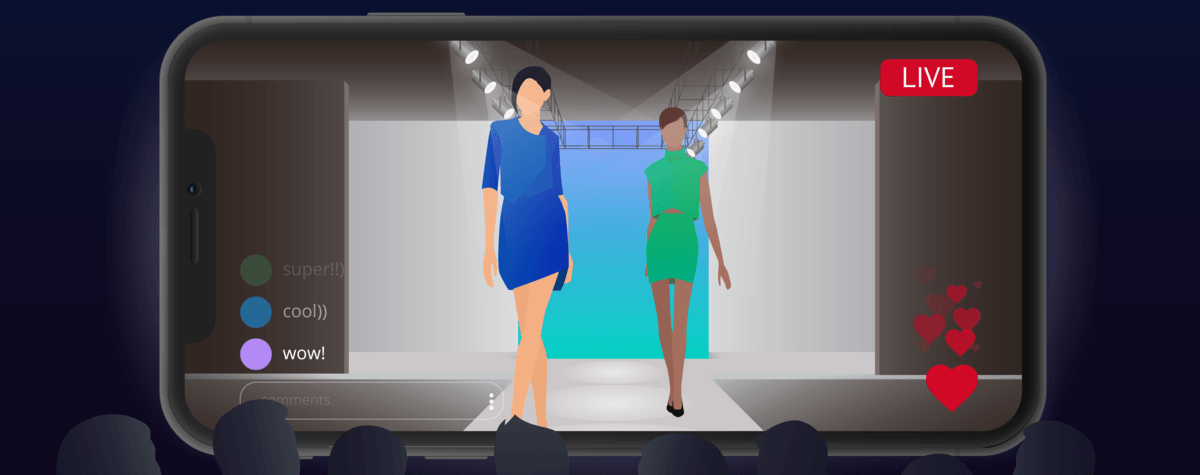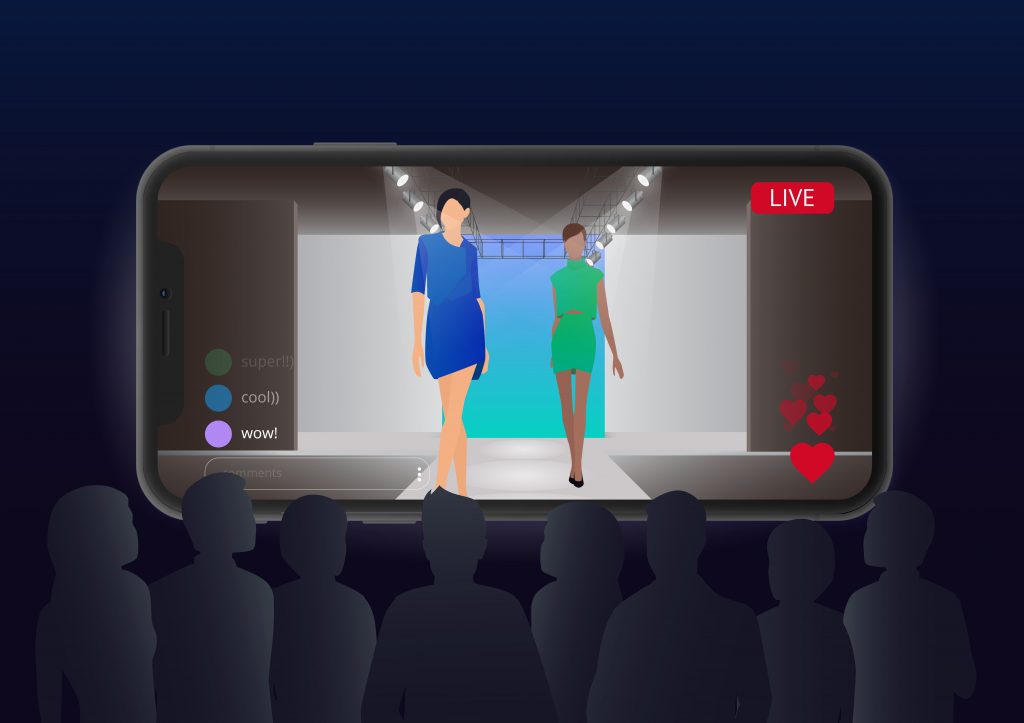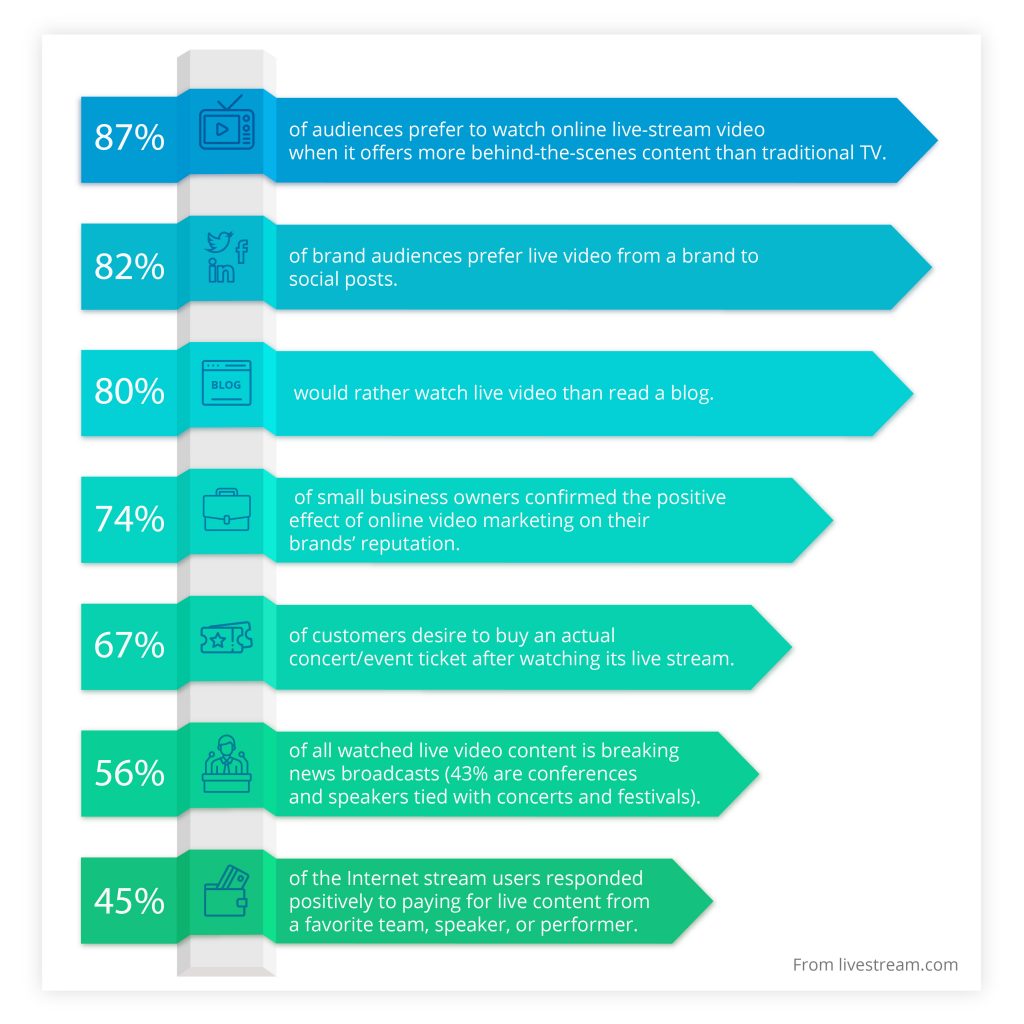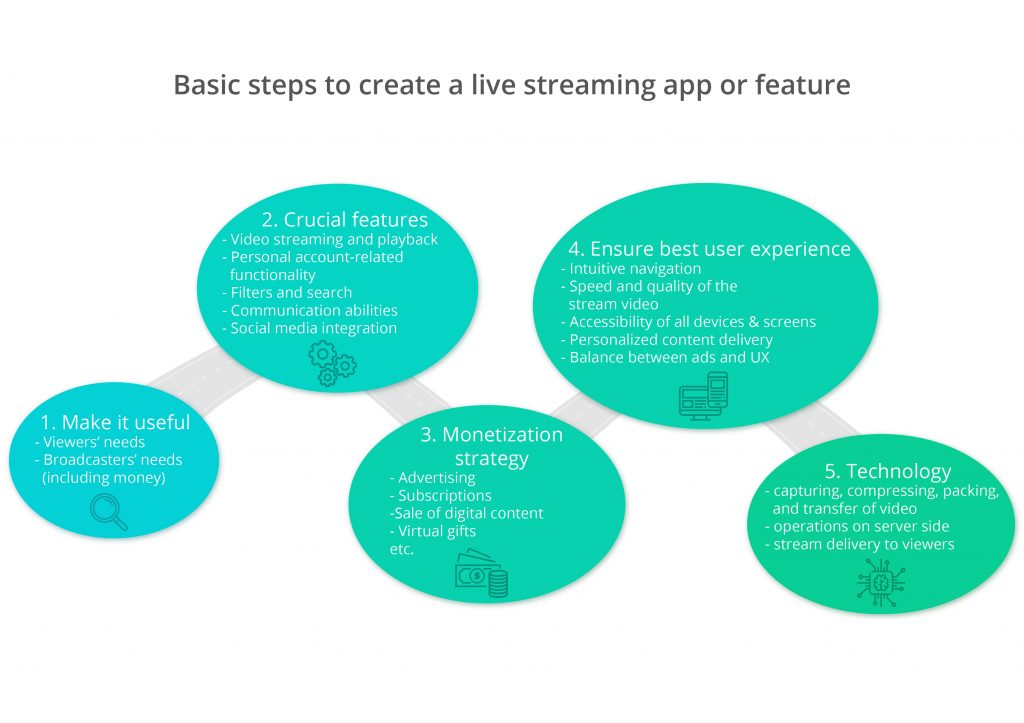How Real Time Video Streaming Can Benefit Your Business

The Internet and mobile applications are the new TV, marketplace, and creative outlet. Internet celebrities are rewriting the rules of marketing and e-commerce. Likes, comments, and shares in social media have become virtually a new currency. The consumers’ attention is almost as valuable as oil or gold. Anything goes when organizations, entrepreneurs, and artists are competing for the precious seconds from every viewer.
What can capture their attention better than something unique taking place right now, never to happen again? That’s it – real-time content. Live video streaming services have been a hot addition to social media and mobile applications recently. Facebook, Twitter, Vimeo, Youtube, and others have joined this trend. If you wonder whether you should do the same, this post may help provide the answer. There’s also a basic roadmap to creating a successful application or a useful addition to an existing app.
How Real Time Video Streaming Can Help Your Business Grow
Live streaming technology allows companies and entrepreneurs to stay connected with followers and friends in real time, providing exclusive content instead of obnoxious ads. Live video streams can take a brands’ inbound marketing to a new level. Thanks to the low cost, they’re affordable for small businesses and individuals.
Real time video streaming can be useful in various areas:
- Leisure and Entertainment: Twitch is the biggest and most popular gaming live video streaming app. Video game fans can watch others playing their favorite games or stream video content themselves. In online dating, live video streaming enables matches to connect virtually before meeting IRL. Chinese dating app Momo experienced dramatic growth after adding the feature in 2015. In the third quarter of 2018, its revenues from live video service made $406.9 million. (If you still wonder how to create an app like Tinder but better, the answer is probably ‘Let them go live!’)
- Retail: Marketing in this industry largely depends on the visual appeal of goods. A demonstration of, say, luxury clothing details in real time can be very alluring. A live-streamed launch of a new product is a great start. Retailers can enhance sales by enabling users to make purchases while watching live video streams.
- Real Estate: Live streaming can be used to display properties to prospective buyers. Users may get info about the location, neighbors, insurance, taxes, etc., within a company’s app, without going anywhere.
- Webinars: Live video streams not only diversify business presentations. They reduce the distance between the seller and buyer. That’s especially valuable for businesses that do not engage with the public directly. Most B2B companies need a platform to provide online consultations or Q&A, share materials, and get an immediate response from the customers.
- Healthcare: Live video streaming technology can facilitate patient support, education and training of interns, conferences with colleagues, interviews, presentations, etc.
- Logistics: Companies can use live video streaming services to control the delivery process. A webcam installed in a truck’s luggage space would stream video for the shipping agents, customers, or other stakeholders. Geolocation and IoT integration will add value to such an application.

Steps to Create a Live Streaming App or Feature for Success
Step 1: Make Live Streaming App or Feature Useful
Live streaming technology allows us to see events through the eyes of the broadcaster. That offers practically full interaction online, erasing geographical boundaries. Reflect on who needs the ability and why, and how they will use it. Focus on meeting the viewers’ and broadcasters’ needs. Every aspect of the video streaming app development must further those purposes.
Before releasing your application, test it with a sufficient number of potential users. That should give the most informative feedback on required improvements.
Step 2. Provide the Essential Features of Live Video Streaming Apps
The crucial features of a live video streaming app include:
- Video Streaming and Playback Functionalities: An MVP or the first version of your mobile application may be limited to online streaming and watching videos in real time. However, most popular applications provide streaming video playback. Subsequent versions should enable the viewers to watch and maybe save the videos after the broadcast ended.
- Personal Accounts: The service must be profile-oriented. Users should be able to create personal accounts, possibly with multiple user profiles, manage their data, email addresses, passwords, and payment options. Enable users to find profiles with similar interests and subscribe to broadcasters. Connecting/importing contacts from social networks and device storage should prove useful. Mechanisms for authentication and a proper set of security components are a must.
- Personalized Content: Effective filters and search help deliver the right content to each user. Provide a quick location-based search for broadcasts. If applicable, users should be able to easily find the content they’ve already watched and liked, as well as recommended broadcasts.
- Communication: Provide broadcasters and viewers with a way to comment. Viewers should be able to rate and/or react emotionally to live streams and saved videos. Be creative with messaging, live polling, user stats, in-app purchases, animations or other means to engage users.
- Social Media Sharing: Viewers should be able to share interesting content and broadcasters with others. Integrate your app with Facebook, Instagram, and other social networks, and add one-click sharing.
- Payment Methods: Live video streaming services, especially targeting different regions, should provide various payment options: credit cards, debit cards, special-use cards, and prepaid credit cards for web and mobile apps.
Step 3. Develop a Smart Monetization Strategy
Real time video streaming can drive exciting revenue opportunities. There’s evidence that brands are going to invest in live streaming advertising heavily in the coming years.

Application publishers can ride the “gravy train”, acting as intermediaries and leaving the promotion to the content generators. Still, it’s crucial to get the right balance between user experience and monetization. When selling video space to advertisers, you should consider the optimal length for an ad, skipping ads, different placement types, etc., and be creative with advertising through keyword types, A/B testing variations, and pre- and post-roll ads.
Make sure ads are in tune with your app and the audience. For example, Twitch provides a place for advertisement in each video stream. They are often used for broadcasting game tournaments. Various companies are sponsoring Twitch, but gaming hardware vendors and game publishers are really at home there. The app also offers an ad-free paid subscription.
Along with dating, Momo’s 110.5 million users employ the platform to project anything from beauty tutorials to music countdowns. Viewers can send broadcasters gifts to catch their attention or to thank them. The application keeps a percentage of each gift’s worth. You can follow other examples from Momo’s monetization model:
- Membership Subscription: A paid membership unlocked exclusive benefits for users: refined search options, ability to view the profiles that had visited their page, offers in the emoticon store, and so on. You may offer a free trial of your streaming application and a flexible system of monthly, quarterly, or yearly subscriptions. Premium accounts or, say, enterprise plan/pro plan may provide more storage space, open access to editing functions, or otherwise extend the basic functionality as needed by paying users.
- Sale of Digital Content: Momo was showcasing value-added services that nest within games and business marketing services. Companies will appreciate an opportunity to set up accounts that users can follow. Another way is to have subscribers pay per view or for access to archived content while real time video streaming is free.
Paid online courses, consultations, and other content protected by copyright make a less popular monetization method. All collected data, e.g., real-time views, sessions per user per month, amount of content consumed per session, engagement levels, etc., can be valuable for interested third parties who will pay for it. Finally, you can resell your live video streaming app to another brand as a ‘white label product’ eventually.
Step 4. Ensure Proper User Experience (UX)
Pay attention to how viewers want to navigate your app’s content, from the menu structure to the stream video speed and quality. Remember that ads are an important part of the UX.
Users should be able to access the video content literally with one click on the homepage. Other useful features to consider are auto-playing on start, continuous playback, ability to restrict access to video, pause and rewind the broadcast, push alerts, picture-in-picture mode or a background mode, download capabilities, and more. Before implementing any feature, app developers should assess the future usage of the functionality vs. the cost.
For an MVP, it makes sense to focus on priority platforms, but viewers want to access content on the whole spectrum of mobile devices and screens. Multiplatform adoption is a way to reach audiences on Android and iOS phones and tablets, Apple TV, Roku, Windows, and wherever people are expecting.
Big data helps app developers improve the UX by displaying personalized suggestions and delivering content in a personalized way. Artificial intelligence can assist in creating models based on demographic information. It lets segment out delivery and provide different experiences to particular user types.
The quality of service can apply to many components of the content delivery, e.g., compression, transmission, delivery, and playback of content. These are mainly determined by the technological stack.

Step 5. Use the Right Technology
The tech stack for creating a mobile video streaming app starts with the means for:
- Capturing video/audio, compressing, packing, and transfer to the streaming server.
- On server side, performing operations aсcording to the business logic, processing, storing, re-encoding, etc., for the incoming streams.
- Delivering the stream to viewers, either by direct delivery or using an intermediate storage. (The latter requires employing a platform for the streaming video but offers more opportunities for marketing research and evaluation of audience coverage.)
It’s important to choose the streaming protocol before designing the system. Real Time Messaging Protocol is the most powerful and optimized protocol for live broadcasting. (More information on RTMP, including Alternative-spaces’ external library for Android, is available in an earlier post.)
The good news is that app developers needn’t build everything from scratch or overhaul an existing tech stack to introduce live streaming to your platform. You can purchase a readymade framework and employ a live streaming platform, e.g., Brightcove, Contus VPlay, DaCast, JW Live, Livestream, UStream or Wowza. Contus VPlay is arguably the best solution for building live video streaming apps for Android and iOS.
Most of the live streaming apps utilize Google Cloud Platform, Microsoft Azure or Amazon Cloud Services. The larger your audience, the more servers and channels are required for guaranteed quick delivery of the content to viewers. Content delivery networks (CDNs) like Amazon CloudFront, Cloudflare, Fastly or Open Connect allow the expedited processing of files. CDNs deliver content at the right time to the right user without the regard of buffering. They have a strong resistance to DDoS attacks and increased fault tolerance to boot.
The programming languages and frameworks used in live video streaming app development include C++, Go, HTML5/CSS3, Java, JavaScript (AngularJS, Backbone, EmberJS, Node.js, React, Restify, and RxJS), Python, and Ruby on Rails.
App developers and publishers should leverage extensive analytics suites run across the entire application. In addition to Google Analytics, MixPanel, Hadoop MapReduce and Spark, major video streaming-specific analytics packages are ComScore, Conviva, and Nielsen.
Summing Up
Live video streams are a growing trend in video marketing. The flow of new interactive video content can increase dwell time and incremental repeat traffic to your platform, boosting advertising and revenue opportunities. Live streaming is not a one-size-fits-all solution. However, if the functionality is useful, intelligently integrated into the system, and supported by unobtrusive monetization methods, live video streaming can be a fantastic growth engine.
Businesses are massively investing in the presence on social media platforms, messengers, and IoT solutions. Leaders choose to create own channels and let others compete for the consumers’ attention there. With a compelling consumer proposition, the development of a live video streaming app may be your best decision ever.
Embarking on building the next Snapchat or YouTube Live, concentrate on the functionalities that users value most. Improve the features, advance, and keep them top notch. A methodical approach to technologies behind the live video content is key to the application’s success.
Alternative-spaces develops scalable mobile and web applications using advanced technologies and latest trends in design. Do you have questions about video streaming application development? Have you envisioned an application with novel functionalities? Are you looking for an experienced team to build an enterprise application? Get in touch with Alternative-spaces!
Content created by our partner, Onix-systems.
 Home
Home